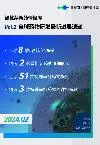Frontier Pharma: Hepatitis C Diverse Range of FirstinClass HostTargeting and DirectActing Antivirals Offer Potential in DifficulttoTreat Populations Prices from USD $6995
2017-01-04
Frontier Pharma: Hepatitis C Diverse Range of FirstinClass HostTargeting and DirectActing Antivirals Offer Potential in DifficulttoTreat Populations
Summary
Hepatitis C is a bloodborne viral infection characterized by chronic inflammation of the liver. Although patients may be asymptomatic for a number of years or decades, chronic HCV infection can lead to liver fibrosis formation of scar tissue and ultimately liver cirrhosis, in which permanent fibrotic scar tissue replaces healthy liver cells. In severe cases, cirrhosis may lead to liver failure and death. In addition, hepatitis C patients are at an increased risk of developing liver cancer.
Hepatitis C has a high global prevalence, with the number of people living with the disease estimated at 130170 million worldwide. Before the arrival of directacting antivirals DAA in 2011, the goldstandard of hepatitis C therapy consisted of the hosttargeting drugs pegylated interferon and ribavirin, which were associated with significant side effects.
After nearly a decade of minimal progress in the development of hepatitis C therapies, the treatment landscape of hepatitis C has evolved substantially in recent years. This has resulted in an increasingly competitive market landscape, and several oral regimens that combine DAAs from different nonstructural NS HCV protein families NS5B polymerase inhibitors, NS5A replication complex inhibitors and NS3/4A protease inhibitors have already been licensed. These new combination therapies have been highly commercially successful and are now regarded as the goldstandard within the treatment algorithm.
Despite the entry of these new therapies, there is a subgroup of patients that do not respond to current treatments, or relapse. In addition, HCV resistance to DAAs may also be a cause for concern, as the development of selection pressure by the host immune system in combination with DAA therapy may lead to outgrowth of resistant viruses. As such, the rationale for investment in firstinclass innovation remains strong.
Firstinclass products account for a relatively small proportion of the hepatitis C pipeline. However, in comparison with historical hepatitis C trends, which saw virtually no firstinclass products approved over a large period up until 2011, the presence of a modest number of these products is promising. The firstinclass targets identified show considerable diversity, and the high number of novel pathways targeted by firstinclass products provides evidence of enhanced divergence in hepatitis C firstinclass innovation in recent years.
Scope
The escalating hepatitis C public healthcare need has resulted in a competitive market landscape
What is the pathophysiology of hepatitis C?
What are the common comorbidities and complications?
How has the emergence of new drug classes in the past decade impacted the treatment algorithm?
What are the most significant unmet needs within the market?
The hepatitis C pipeline is relatively large and innovative
Which molecule types and molecular targets are most prominent within the pipeline?
Which firstinclass targets are most promising?
How does the ratio of firstinclass targets to firstinclass products differ by stage of development and molecular target class?
The hepatitis C deals landscape is highly active
Do hepatitis C products attract high deal values?
Which molecule types and molecular targets dominate the deals landscape?
Which firstinclass pipeline products have no prior involvement in licensing or codevelopment deals?
Reasons to buy
This report will allow you to
Appreciate the current clinical and commercial landscapes by considering disease pathogenesis, etiology, epidemiology, symptoms, comorbidities and complications, and treatment options and algorithms.
Visualize the composition of the hepatitis C market in terms of dominant classes of therapies. Key unmet needs are identified to allow a competitive understanding of gaps in the market.
Recognize innovative pipeline trends by analyzing therapies by stage of development, molecule type and molecular target.
Assess the therapeutic potential of firstinclass targets. Using a proprietary matrix tailored to hepatitis C, all firstinclass targets in the hepatitis C pipeline have been assessed and ranked according to clinical potential. Promising earlystage targets have been further reviewed in greater detail.
Consider firstinclass pipeline products with no prior involvement in licensing and codevelopment deals that may represent potential investment opportunities.
立即开始免费试用!
智慧芽新药情报库是智慧芽专为生命科学人士构建的基于AI的创新药情报平台,助您全方位提升您的研发与决策效率。
立即开始数据试用!
智慧芽新药库数据也通过智慧芽数据服务平台,以API或者数据包形式对外开放,助您更加充分利用智慧芽新药情报信息。



